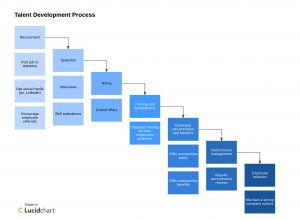Strategic human resource planning is a process that recognises current and anticipates future human resources needs in order for an organisation to be able to achieve its goals. Without human resource planning, there would be no link between human resource management and the overall strategic plan of a business. The aim of strategic planning is to create a seamless bond between human resource management and the overall strategic plan of a corporation.
Strategic human resource planning is an important component of HR management. Most mid – to large sized organisations have a strategic plan. This plan will effectively guide them in successfully meeting their mission goals.
Even a small start-up business with as few as 10 staff can use Strategic human resource planning to guide decisions about the future. Strategic HR planning will allow you to make HR management decisions confidently that you now are going to be able to support the future direction of the organisation. Budget is also vitally important when human resource planning because it allows the planners to factor the costs of recruitment, training, etc. into the yearly operating budget.
The overall purpose of Strategic human resource planning is to ensure adequate human resources are allocated to meet the strategic goals and operational plans of your organisation – this in simple terms means hiring the right people with the correct skills at the appropriate time. It is also important when Strategic HR planning to remember to keep up with social, economic, and technological trends that could have a significant impact on human resources in your area and in-prearticular in your market the sector. It is imperative that you are not inflexible. A degree of flexibility is needed so that your business model can adapt and change if the future is different than anticipated.
Strategic human resource planning predicts the future HR needs of the organisation after analysing the organisation’s current human resources capacity, the external labour market and the future environment that the organisation will be operating in. The analysis of HR management issues external to the organisation and developing scenarios about the future is what distinguishes strategic planning from operational planning.
The final stage of planning is integration, HR must now take practical steps to integrate its plan with the rest of the company. To integrate the plan successfully within the whole company HR need a budget, the ability to implement the plan and a collaborative effort with all departments to make the plan happen. The aim of the planning process is to have the ideal amount of staff to make the most money for the company. Because the goals and strategies of the company change over time, human resource planning is a regular occurrence.
Departments within larger businesses are the name given to the way they organise people by their function E.G. human resources, marketing, administration, and sales.
Departments are organised in a way that best supports the:
- delivery of the department’s services,
- attainment of the department’s goals,
- accomplishment of the unit’s purpose or mission within the organisation, and
- achievement of the organisation’s goals.
Follow the Steps below to complete competent strategic human resource planning
- Assess current HR capacity
The first step in the strategic human resource planning process is to evaluate your existing staff. Before making any changes to your organization or hiring new employees, it’s important to appreciate the talent you already have at your disposal. - Forecast HR requirements also called Gap analysis
Once you have a full account of the employee talent you already have at your disposal, it’s time to begin anticipating future needs.
Questions to answer at this stage include:
What new jobs will we need?
What new skills will we need?
Do our current staff have the necessary skills?
are our staff currently playing to their strengths?
Are current HR practices suitable to meet our future goal? - Estimating the Demand
This is the detailed process of deciding on future human resources requirements in terms of the number of employees needed and the calibre of talent required to meet the company’s current and future needs. - Estimating the Supply
This is when you need to estimate the current resources available to meet the demands. By checking your list, you made of pre-existing talent, you’ll know which employees in your organization are available to meet your current demand. You’ll also want to look at external potential hires outside of the organization that can meet the needs not satisfied by staff already present in the company. - Matching the demand and supply
This is where the hiring process gets complicated and the remaining parts of the strategic human resource planning process fall into place. First, develop a plan to link your businesses need for qualified staff with the amount available in the current candidate pool. You can make up the shortfall by training current employees, hiring new employees, or combining the two approaches. - Develop talent strategies
After defining your company’s employment needs by evaluating your current HR budget and predicting supply and demand, it’s time to begin the process of developing and adding talent. Staff development and training are a crucial part of the strategic human resources management process. - The chart below gives an overview of the talent development process

- Review and evaluation
Once your human resource management process plan has been in place for a while, you can evaluate whether the plan has helped the company to achieve its goals in terms of production, profit, retaining employees, and the satisfaction of employees.
